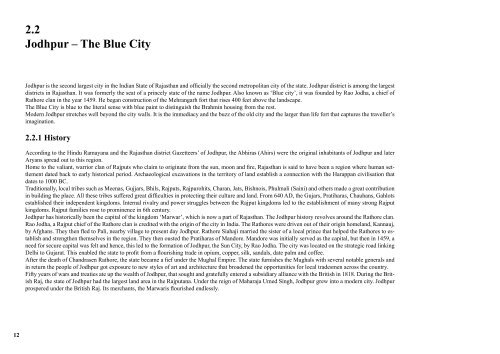Create successful ePaper yourself
Turn your PDF publications into a flip-book with our unique Google optimized e-Paper software.
2.2<br />
Jodhpur – <strong>The</strong> Blue City<br />
Jodhpur is the second largest city in the Indian State of Rajasthan and officially the second metropolitan city of the state. Jodhpur district is among the largest<br />
districts in Rajasthan. It was formerly the seat of a princely state of the name Jodhpur. Also known as ‘Blue city’, it was founded by Rao Jodha, a chief of<br />
Rathore clan in the year 1459. He began construction of the Mehrangarh fort that rises 400 feet above the landscape.<br />
<strong>The</strong> Blue City is blue to the literal sense with blue paint to distinguish the Brahmin housing from the rest.<br />
Modern Jodhpur stretches well beyond the city walls. It is the immediacy and the buzz of the old city and the larger than life fort that captures the traveller’s<br />
imagination.<br />
2.2.1 History<br />
According to the Hindu Ramayana and the Rajasthan district Gazetteers’ of Jodhpur, the Abhiras (Ahirs) were the original inhabitants of Jodhpur and later<br />
Aryans spread out to this region.<br />
Home to the valiant, warrior clan of Rajputs who claim to originate from the sun, moon and fire, Rajasthan is said to have been a region where human settlement<br />
dated back to early historical period. Archaeological excavations in the territory of land establish a connection with the Harappan civilisation that<br />
dates to 1000 BC.<br />
Traditionally, local tribes such as Meenas, Gujjars, Bhils, Rajputs, Rajpurohits, Charan, Jats, Bishnois, Phulmali (Saini) and others made a great contribution<br />
in building the place. All these tribes suffered great difficulties in protecting their culture and land. From 640 AD, the Gujars, Pratiharas, Chauhans, Gahlots<br />
established their independent kingdoms. Internal rivalry and power struggles between the Rajput kingdoms led to the establishment of many strong Rajput<br />
kingdoms. Rajput families rose to prominence in 6th century.<br />
Jodhpur has historically been the capital of the kingdom ‘Marwar’, which is now a part of Rajasthan. <strong>The</strong> Jodhpur history revolves around the Rathore clan.<br />
Rao Jodha, a Rajput chief of the Rathore clan is credited with the origin of the city in India. <strong>The</strong> Rathores were driven out of their origin homeland, Kannauj,<br />
by Afghans. <strong>The</strong>y then fled to Pali, nearby village to present day Jodhpur. Rathore Siahaji married the sister of a local prince that helped the Rathores to establish<br />
and strengthen themselves in the region. <strong>The</strong>y then ousted the Pratiharas of Mandore. Mandore was initially served as the capital, but then in 1459, a<br />
need for secure capital was felt and hence, this led to the formation of Jodhpur, the Sun City, by Rao Jodha. <strong>The</strong> city was located on the strategic road linking<br />
Delhi to Gujarat. This enabled the state to profit from a flourishing trade in opium, copper, silk, sandals, date palm and coffee.<br />
After the death of Chandrasen Rathore, the state became a fief under the Mughal Empire. <strong>The</strong> state furnishes the Mughals with several notable generals and<br />
in return the people of Jodhpur got exposure to new styles of art and architecture that broadened the opportunities for local tradesmen across the country.<br />
Fifty years of wars and treaties ate up the wealth of Jodhpur, that sought and gratefully entered a subsidiary alliance with the British in 1818. During the British<br />
Raj, the state of Jodhpur had the largest land area in the Rajputana. Under the reign of Maharaja Umed Singh, Jodhpur grew into a modern city. Jodhpur<br />
prospered under the British Raj. Its merchants, the Marwaris flourished endlessly.<br />
12




